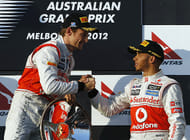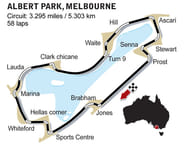Formula 1 is coming back this weekend, and it starts with the 58 laps of the 2015 Formula 1 Rolex Australian Grand Prix. This will be the 66th edition of the Formula 1 World Championships and in it the thirty-first running of the Australian race. Melbourne is once again the place for the opening round, and this will be the twentieth time that the race in Down-Under is to be held at the city’s Albert Park Street Circuit. This year of Formula 1 opens with Australia, and then we literally go around the world, before the Abu Dhabi race, the twentieth round of the season, plays host to the grand finale in late November.
The characteristics of the Melbourne Grand Prix circuit:
The 5.303 kilometers or 3.295 miles long Albert Park Circuit actually plays host to a street-race. The whole track is wrapped around the Lake Albert Park and the circuit is just few kilometers away from downtown Melbourne. The track has 16 turns and uses a good chunk of the public roads, and like all the street circuits; it is bumpy, twisty, challenging, fast and unforgiving in nature.
The track has many undulation changes, and since it is a street track, the road surface is not smooth as compared to other permanent circuit. Also, the fence barriers and the gravel traps around the circuit is situated right beside the race-track, hence if a driver makes a mistake, he might end on them
The whole circuit is fast and very flowing in general, and hence it promotes overtaking thanks to the few heavy braking points it possesses. Also, the track has one long straight, the pit stretch, and a few other high speed zones, hence wheel-to-wheel racing is possible. Overtaking is also felicitated by the fact that the track has two DRS (Drag Reduction System) zones. One falls right over the start finish straight, while the other one just after turn 2. However, both the zones have only one single detection point, which is located right before turn 14.
The tire and the pit strategy:
Because the track is a street type circuit, which uses public roads, the road-surface does not have the same amount of grip compared to other dedicated race-tracks. Hence, Pirelli trucks are going to throw in the medium and the soft compounds tiers for the weekend. Also, when you talk about tires, you have to talk about race-strategies. And, like the last year’s race, expect a very simple 2 stop strategy for all the cars. However, do not be surprised if teams try to experiment and guesstimate different tire and strategy scenarios. No rain is expected during the weekend, and the weather will stay partially cloudy and sunny, through-out.
The change of rules and regulations in 2015
Unlike last year, when the V6 turbo engines were introduced to the sport, there has not been a significant alteration in rules or regulations for the 2015 season. Minor changes have been made though, and the introduction of a new 10 second time-penalty and the Virtual Safety Car system (a scenario tested last year after Jules Bianchi’s horrific crash at Suzuka, Japan) leads the line.
Also, new, but every insignificant, regulations changes about, safety car overtaking, pit lane race starts and actual grid race-starts will be implemented this year.
The ban on helmet changing and double points:
In a very strange move, the FIA has decided, and then has subsequently ordered all the drivers not to change their helmet pattern and design during the season. From Melbourne to Abu Dhabi, drivers must obey and use one single helmet design. FIA believes that this way helmets will be more iconic and prominent in nature.
Also, mercifully for all the fans of the sport; the ‘Double Points’ rule has been scrapped altogether. So, this year at Abu Dhabi you will not see any individual driver scoring 50 points for a win and so on.
The ever changing qualifying format:
Qualifying formats, for all the race-weekends this season, may vary upon the inclusion or exclusion of Manor-Marussia. Although, a top 10 shootout in the final and the third part of qualifying is set to happen at every weekend, but any alterations occurring to the first two parts of Qualifying may depend on the cash-strapped team’s presence.
If the team makes it to Australia, then we are sure to have a qualifying format where the 5 slowest cars each drop out from the first and second part of Qualifying. And, if Manor-Marussia fails to turn up and race, then 4 each will drop off from both the segments. Remember the grid will have 20 cars if Marussia-Manor race, and 18 if they do not.
Team and driver changes over the winter:
As you know, winter is the time when drivers and teams make their transfer moves and accommodate changes respectively. And, pre-season testing was the first time we saw these changes coming to life. But, officially all the re-fashion will see the light of the day in Australia, the venue for the season opener. In a nutshell, the change of Fernando Alonso from Ferrari to McLaren had promoted many domino effect-changes at the end of last year. Sebastian Vettel jumped in to replace the Spaniard at the Scuderia. And, Daniil Kyvat took the quadruple world champion’s position at Red Bull. Although, Alonso will not be able to make his comeback for McLaren in Australia, because he is yet to fully recover from his pre-season testing accident at Barcelona. McLaren reserve driver, Kevin Magnussen, who finished second last year at Albert Park, will take his place instead.
Toro Rosso and Sauber have also gone in with an all-new driver lineup. The Italian squad has signed an all-rookie selection of; Max Verstappen (who at seventeen will make history in Australia by becoming the youngest driver-ever in the sport) and Carlos Sainz Junior. While, the Swiss team Sauber has roped in Marcus Ericsson and Brazilian youngster Felipe Nasr, but a recent court verdict has put a brake on their plans of running the pair in Australia. Finally, it is still a mystery whether Marussia-Manor will race in Australia or not, but they have already signed up Roberto Merhi and Will Stevens as their race drivers.
In terms of team changes, McLaren has ditched Mercedes power units for this season and have re-united with Honda in a hope to re-emulate their successful partnership in the late eighties and early nineties. Lotus has roped in Mercedes in place of Renault power. And, finally, Caterham has officially closed its doors and will not feature in F1 this year.

Last 5 Winners of the Australian Grand Prix:
| Year | Driver (Nationality) | Team Name |
| 2014 | Nico Rosberg (Germany) | Mercedes AMG Petronas F1 Team |
| 2013 | Kimi Raikkonen (Finland) | Lotus-Renault F1 Team |
| 2012 | Jenson Button (United Kingdom) | Vodafone McLaren-Mercedes |
| 2011 | Sebastian Vettel (Germany) | Red Bull Racing |
| 2010 | Jenson Button (United Kingdom) | Vodafone McLaren-Mercedes |
The current team and driver records at the Australian Grand Prix
The drivers’ legends:
| Number of Wins | Driver (Nationality) | Team(s) and year of win |
| 3 | Jenson Button (United Kingdom) | Brawn (2009), McLaren (2010,2012) |
| 2 | Kimi Raikkonen (Finland) | Ferrari (2007), Lotus (2013) |
| 1 | Fernando Alonso (Spain) | Renault (2006) |
| 1 | Lewis Hamilton (United Kingdom) | McLaren (2008) |
| 1 | Sebastian Vettel (Germany) | Red Bull (2011) |
The teams as constructors’ legends:
| Number of Wins | Team Name | Years |
| 11 | McLaren | 1986, 1988, 1991, 1992, 1993, 1997, 1998, 2003, 2008, 2010, 2012 |
| 7 | Ferrari | 1987, 1999, 2000, 2001, 2002, 2004, 2007 |
| 5 | Williams | 1987, 1999, 2000, 2001, 2002, 2004, 2007 |
Note: Only F1 world championship races counted, minimum 3 win-teams listed.
Track Record:
2014 Pole Time: Lewis Hamilton, Mercedes 1:44.231
2014 Fastest Lap Time: Nico Rosberg, Mercedes 1:32.478
Lap Record: Michael Schumacher, Ferrari 1:24.125 (Year 2004)

